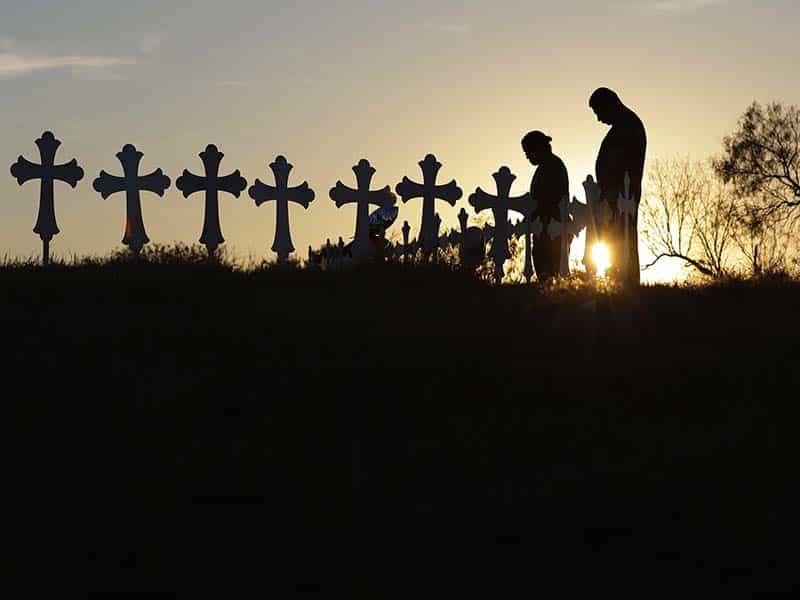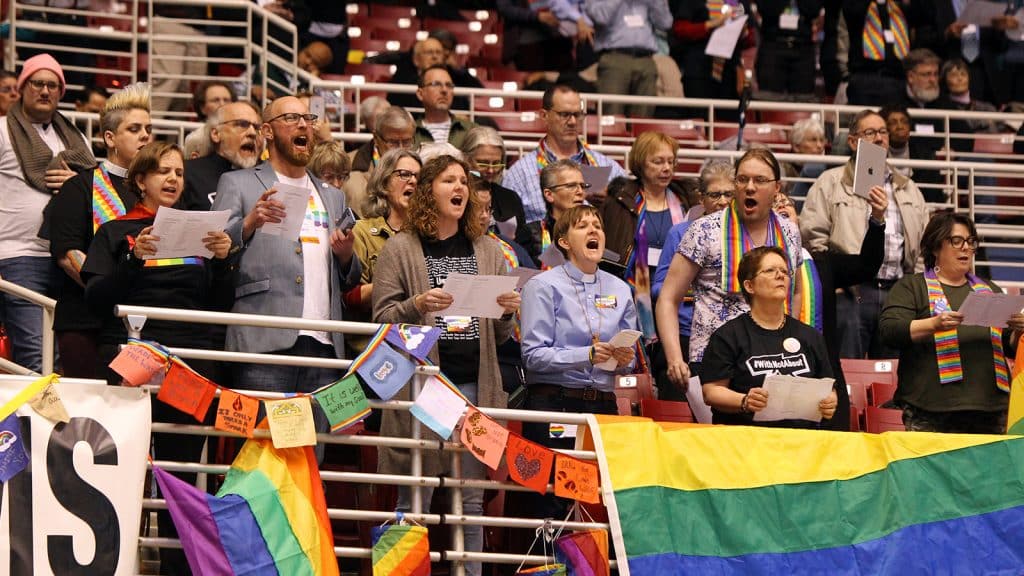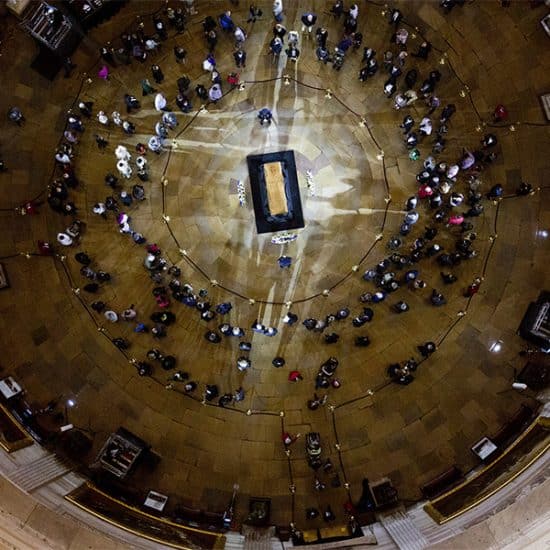

Kenneth and Irene Hernandez pay their respects as they visit a makeshift memorial with crosses placed near the scene of a shooting at the First Baptist Church of Sutherland Springs, Monday, Nov. 6, 2017, in Sutherland Springs, Texas. A man opened fire inside the church in the small South Texas community on Sunday, killing and wounding many. (AP Photo/Eric Gay)
(RNS) — “God surprises us,” Pope Benedict XVI said in 2010, in a Christmas broadcast for the BBC. Assuring the English-speaking world that God always fulfills his promises, the pontiff cautioned that the divine doesn’t always do so in ways we expect.
Neither did Benedict. Three years later, he became the first pope in half a millennium to resign his seat, making way for the election of Jorge Mario Bergoglio of Argentina, the first Jesuit pope and the first from the New World. It was already the biggest religion story of the decade before Pope Francis began his unmaking of Benedict’s stern, “small church” Catholicism, allowing more room for divorced and LGBT Catholics and inspiring the world outside the church with his compassion.
But Benedict’s brief tenure seemed to foreshadow many of the major religion stories of the 2010s — in Catholicism and all faiths. In his critique of Islam as a faith with violent roots, his defense of faith against secular culture and his acknowledgment — the first by a pope — of the resurgent sexual abuse crisis, Benedict’s concerns prefigured the themes of Religion News Service’s coverage for the rest of the 2010s. A look back at the stories that drove religion news in the past 10 years:
Islamophobia
Ten years after the event, the echoes of 9/11 continued to reverberate. In New York, an ill-fated attempt by a group of New York Muslims to open a community center near the former World Trade Center site ended in a sordid anti-Muslim squabble. The next year, U.S. Rep. Peter King of New York held congressional hearings to examine “The Extent of Radicalization in the American Muslim Community and that Community’s Response,” inviting stories of American youth converted to “radical Islam.”
As the 2012 presidential primaries got underway, some candidates stoked fear of Islam, amplifying warnings from right-wing groups that, in the words of one hopeful, Herman Cain, “there is a creeping attempt to gradually ease Shariah law and the Muslim faith into our government.”
Four years later, Donald Trump made suspicion of Muslims a theme of his successful campaign for the White House, and after he took office, his order to refuse entry to citizens of several majority-Muslim nations sparked protest at U.S. airports. Courts forced the administration to moderate the ban, but didn’t silence the president’s vows to eradicate “radical Islamic terrorism” or his retweeting of incendiary anti-Muslim videos.
The resurgence of the clergy sex abuse crisis
The 2016 Oscar for best picture went to “Spotlight,” chronicling The Boston Globe’s investigation into child sex abuse by priests that resulted in the resignation of Boston’s archbishop, Cardinal Bernard Law, in 2002.
But with the numbers of new abuse cases declining sharply, the 2010s opened a new phase of the scandal: the prosecution of clerical administrators who concealed abuse. In June 2012, Philadelphia’s Monsignor William Lynn was convicted of covering up priestly crimes; in September of that year, Bishop Robert Finn of Kansas City, Missouri, became the first bishop to be found guilty of failing to act on reports of clergy abuse, and in 2015 Finn resigned as diocesan bishop after a Vatican investigation.
Two years after that, Pennsylvania Attorney General Joshua Shapiro impaneled a grand jury to look into sex abuse in the Catholic Church in his state. The ensuing report named 301 allegedly abusive priests and spurred more than a dozen probes in other states. In the fallout, Cardinal Donald Wuerl, a former bishop of Pittsburgh, left his post as archbishop of Washington, just months after his predecessor, Theodore McCarrick, had resigned from the College of Cardinals following allegations of his abuse of minors and seminarians.
#ChurchToo
Catholics were not the only faith beset by allegations of sexual misconduct or ignoring the voices of the abused. In April 2019, four years after accusations of sexual impropriety were first weighed against him, megachurch pioneer Bill Hybels was forced into early retirement after a Chicago Tribune article detailed his alleged advances toward female members of his Willow Creek Community Church dating back to 1998. Hybels’ successors as pastor and Willow Creek’s governing elders resigned for mishandling the allegations.
Nearly two years before, a similar storm had hit the Southern Baptist Convention, when Paige Patterson, an architect of the conservative takeover of the SBC in the 1980s, was fired as Southwestern Baptist Theological Seminary president over his treatment of women who had brought claims of sexual assault and domestic abuse to him. He was the first prominent figure to fall in the movement known as #ChurchToo, through which abuse survivors pushed back against the dismissiveness of church leaders.
The questioning about the treatment of women fed growing dissatisfaction about women’s limited roles in the Southern Baptist Convention — and a backlash, as conservatives cautioned popular author and speaker Beth Moore about activities that they said veered too close to preaching.
The rise of the ‘nones’
A 2012 report by the Pew Forum on Religion & Public Life shows that the group Pew refers to as “nones” — “people who self-identify as atheists or agnostics, as well as those who say their religion is ‘nothing in particular,’” according to Pew — have increased from just over 15% to just under 20% of all U.S. adults, and a following 2015 study portrayed them as the fastest growing religious group in the United States. Today, according to the Public Religion Research Institute, more than a quarter of the country (26%) falls into this unaffiliated category. The rapid increase of the sector, most noticeable among white millennials, is judged to have huge implications, for the growth of Christian churches and the political concerns of Americans as a whole.
“This demographic and cultural sorting means that our partisan conflicts are increasingly driven not just by political disagreement but by entire worldviews that are rooted in religious, racial and generational values and identities,” writes Robert P. Jones, CEO and founder of PRRI.
Mass shootings at houses of worship
Attacks on people at worship have been on the rise, with as many occurring in the decade before 2016 as in the 25 years previous. Like most mass shootings, they are rare, and rarely aimed at the religion itself. Rather, they tend to be connected to domestic disputes and personal resentments, as was the case in the deadliest ever shooting at an American place of worship, at Sutherland Springs, Texas, in November of 2017. More than two dozen people died at the hand of a man seeking retribution against his estranged wife.
But some of the most horrific shootings at houses of worship in the 2010s seemed to be motivated by antipathy toward the identity of those at prayer — or, often, the mistaken notions of who they were.
In 2012, a man later described as a neo-Nazi killed six people at a Sikh gurdwara outside Milwaukee. In 2015, a 21-year-old man killed nine African American congregants at Mother Emanuel church in Charleston, South Carolina, claiming to defend the white race. In October of 2017, the worst anti-Semitic attack in U.S. history took place at the Tree of Life synagogue in Pittsburgh, when a man who was convinced that Jews were facilitating immigration to the U.S. killed 11 mostly elderly worshippers there.
Gay ordination and gay marriage
Official acceptance of the sexual orientation of LGBT people has roiled the Christian church at large for more than five decades, and the 2010s seemed to bring the issue no closer to being settled. In 2010, the Presbyterian Church (U.S.A.) allowed openly gay men and women to be ordained as clergy, and the following year opened the way for married gay clergy to serve as well. Three years later, Guy Erwin was elected bishop of the Evangelical Lutheran Church in America’s Southwest California Synod, the first openly gay bishop in the denomination.
Attitudes about same-sex relationships continued to shift quickly as the decade went on, until, in June 2015, the U.S. Supreme Court struck down the remaining state bans against marriage between couples of the same sex. Yet by the end of that year, only the most liberal mainline Christian denominations, as well as Reform and Conservative Judaism, sanctioned weddings for same-sex partners, while Baptists of all stripes, Catholics, Orthodox Jews and the second most populous Protestant denomination, the United Methodist Church, refused gay couples.

LGBTQ advocates react to the Traditional Plan being passed by the UMC General Conference on Feb. 26, 2019. RNS photo by Kit Doyle
The United Methodists would soon come to a reckoning on the issue. In a special meeting of the global church in February of 2019 in St. Louis, delegates voted to reinforce its Book of Discipline’s strictures against ordaining LGBT ministers or marrying anyone of the same sex. The decision threatens to pull the denomination apart.
Evangelicals in power (and the rise of post-evangelicals)
In 2012, the GOP’s Mitt Romney became the first Mormon to be nominated by a major party for president, seemingly breaking evangelical Christians’ hold on the Republican Party’s standard-bearer. But in the general election, evangelicals supported Romney as strongly, if not as enthusiastically, as they had the affirmed evangelical George W. Bush.
Four years later the evangelicals’ identification with the GOP was even more complete, as they voted overwhelmingly for Donald Trump, overcoming doubts about the erstwhile New York playboy and gambling mogul’s temperament and morality. They were rewarded when Trump not only put forward Supreme Court nominees with anti-abortion and pro-religious freedom views, but invited a coterie of evangelical leaders known as his unofficial evangelical advisers into the Oval Office.
In a decade that would see Billy Graham, a frequent visitor to the White House for 50 years, retire from public life before passing away in 2018, Trump’s bond with prominent evangelical pastors cemented a new link between the GOP and conservative Christianity.
If the evangelical powerful elite seemed to come into their own in Washington — symbolized by the opening of the $500 million Museum of the Bible south of the National Mall — younger evangelicals quietly began questioning their elders’ social and theological positions.
In 2011, pastor Rob Bell was roundly criticized for “Love Wins,” a book in which he attempted to soften the traditional evangelical conception of hell. Unrepentant, he soon left Mars Hill, the church he’d founded in Michigan, for California. In 2014, Rachel Held Evans, a cradle evangelical, reissued her 2008 book “Evolving in Monkey Town,” which recounts her journey from evangelicalism to a more openly questioning faith. When she died at the age of 37 in 2018, her influence, and the “post-evangelical” movement she had helped kick off, became apparent in the public mourning of her fanbase on social media. While Bell and Held Evans continued to teach and write from a Christian perspective — representatives for a post-evangelical movement calling for reform within the church — many others chose to leave altogether. The hashtags #exvangelical and #emptythepews became rallying cries for a disenfranchised group of the previously faithful who no longer saw hope within institutionalized religion.
Anti-Semitic attacks
In the second half of the decade, hate crimes against Jews began to rise sharply, increasing by 60% in the U.S. from 2016 to 2017, according to the Anti-Defamation League, and doubling on American campuses. The trend was driven in part by emboldened white supremacist groups, whose public rallies became commonplace. At one such demonstration in Charlottesville, Virginia, in 2017, white supremacists waved Nazi insignia and chanted “Jews will not replace us.”
As the decade wore on, assaults against Jews, as well as anti-Semitic sentiment in politics, became more common in Europe as well. In France, Jewish cemeteries were desecrated, while in England Jewish members of the opposition Labour Party quit in protest after the leadership refused to adequately respond to anti-Semitic remarks in the party ranks.
In the U.S., the decade ended with a burst of attacks, including the Tree of Life synagogue shooting (see above); a series of assaults on Orthodox Jews in the Brooklyn borough of New York; a white supremacist attack at a synagogue in Poway, California; a shooting at a kosher supermarket in New Jersey; and a multiple stabbing at a rabbi’s home in the Orthodox haven of Monsey, New York.
Religious freedom
The right to practice one’s faith and to equal treatment was severely challenged around the world in the past decade, as Myanmar’s Rohingya Muslim minority was subject to atrocities and forced into refugee camps in neighboring Bangladesh and China’s Uighurs were forced into reeducation centers. In India the 2014 election of Prime Minister Narendra Modi, a Hindu nationalist, continues to spur fears of discrimination against religious minorities. In Nigeria, Boko Haram and splinter group the Islamic State West African Province have elevated the country to the U.S. religious freedom watch list, with continued violence against both Christians and Muslims in the nation. The decade ended with the execution of 11 Christians in a Christmas video and the beheading of a bridal party.
At home, the cause of religious freedom played out in two highly watched Supreme Court cases, one that ruled that two companies owned by conservative Christians — Hobby Lobby and Conestoga — could claim religious objections to the contraceptive mandate in the Affordable Care Act; the other that narrowly protected a baker in Colorado from being required to accommodate a gay couple who asked him to provide them a cake for their wedding.

